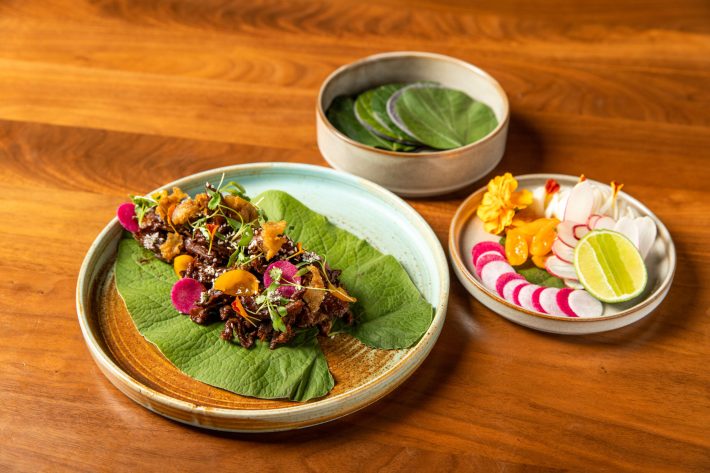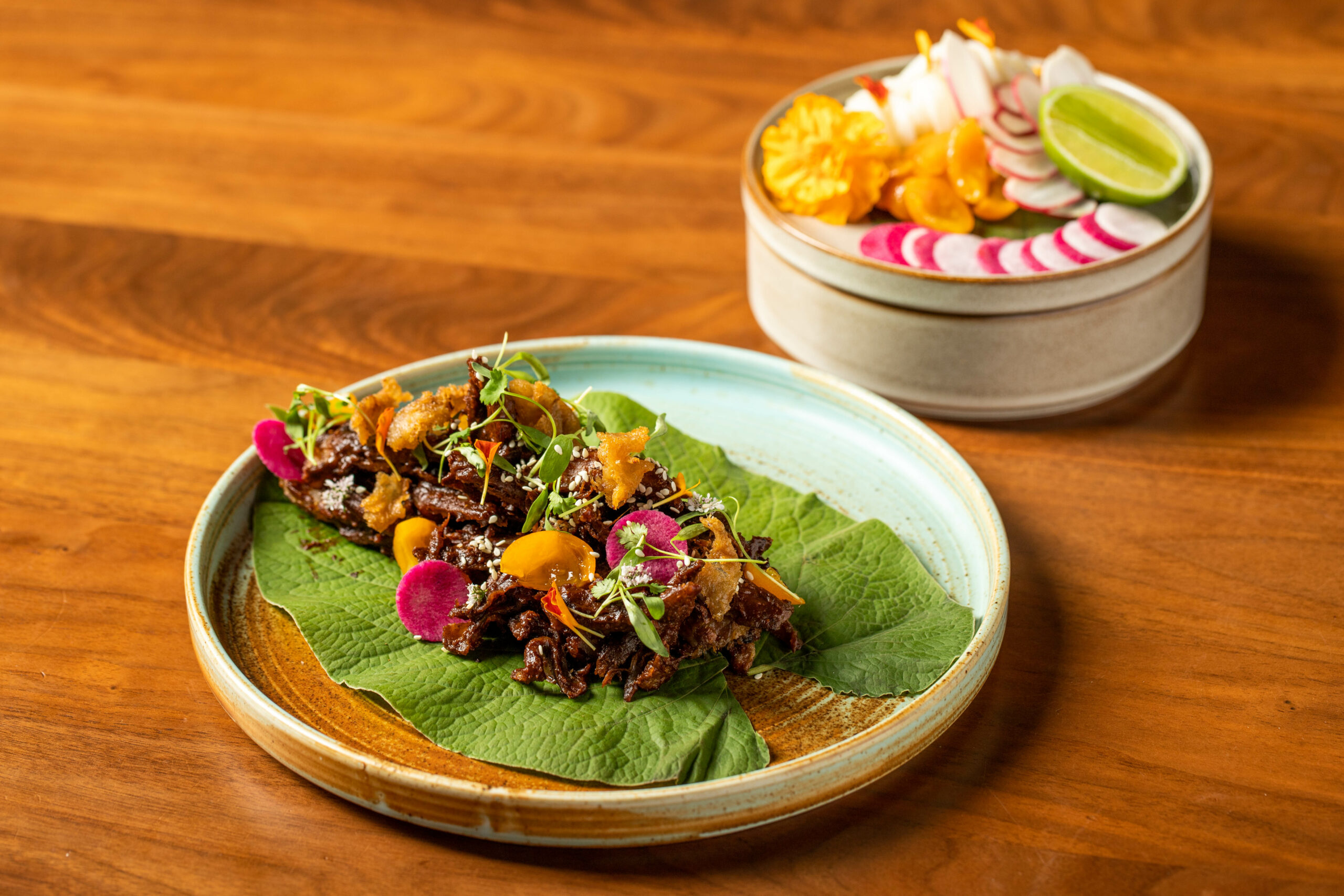At West Hollywood’s Conservatory, a beautiful and high-end restaurant on Santa Monica Boulevard right where Irv’s Burgers long resided, Guadalajara-raised chef, Victor Muñoz is conducting an ongoing experiment in mole evolution.
His trials are focused on the traditional mole negro he first prepared on September 16, 2021, which he calls his “madre mole,” with ensuing efforts to turn it into an ever-morphing sauce he sustains and continually changes through the introduction of new ingredients, notably the seasonal fruits, vegetables, and nuts brought to the restaurant by partner farms.
Muñoz’s goal is to consistently imbue greater complexity to the mole, while still maintaining the essence that makes it irrefutably a mole, with all the sensations that provoke nostalgia for the dish in those who were raised on it.
“Mole is something I grew up eating,” he tells L.A. TACO. “It’s a sauce that I feel represents the complexity of Mexican cuisine itself.”

Muñoz has worked at some of the most famous restaurants in the world, including Noma and Eleven Madison Park, as well as during a sustained stint with legendary Lyonnaise chef Paul Bocuse. But it probably comes as no big surprise to learn he staged at Mexico City’s Pujol in 2018, where he marveled at owner Enrique Olvera’s famous mole negro that has been kept alive and transformed over many years.
“His cuisine was a lot different,” chef Victor notes. “Complex Mexican cuisine that shows how we can take each ingredient and adapt it to its environment. He wanted to have a mole that was like a living organism. We cure and age proteins, why can’t we do that with certain sauces? I think that exploration is a great way of going about it. It was such an eye-opener.”
Muñoz’s own experiments began soon after in a restaurant in his adopted hometown of Orlando, Florida. After significant trial and error, he tasted his first victory upon learning that he could keep a base mole in a drip pan covered with vinegar-dipped cheesecloth to keep it free of invading bacteria. The next challenge was to bring in Southern California’s renowned seasonality and a regional flair.
“Every other day, we reheat the mole and add some sort of new ingredient based on seasonality to give it more character,” he says. “The mole evolves on its own. Sometimes it’s nice, sometimes it’s playful, sometimes it’s going to be angry, which depends on the chiles or the chocolate, or certain nut or fruit that we’re using.”
Since September, Muñoz has added many new ingredients to align with winter, including Fuji persimmons, mulled figs, kumquats, parsnips, maduros, Weiser Farms butternut squash, and a calabaza from Girl & Dug that the prep-intensive chef caramelizes to bring out its hints of butterscotch, whiskey, and walnuts. He doesn’t add willy-nilly, but when someone brings him something special, they’ll divide the madre mole by quarts and play around with different techniques to see what works, without sacrificing the mole’s true character or texture.
Oftentimes he’ll substitute the sweetness of a certain fruit, like caramelized figs made with a splash of Negro Modelo, sous vide squash with whiskey, thyme, and canela, or persimmon juice, for the piloncillo he initially employed, among other substitutions that take the place of traditional ingredients.
“Mole is one of those sauces that has to renounce its individuality,” Muñoz tell us. “Every ingredient has to come together and create that perfect harmony. You have to find ways to balance the mole and still have someone that’s Mexican and has been eating mole their whole life come and try it, and they recognize it right off the bat. The palate is like, ‘yes, that’s mole, but what’s that lingering taste?’ We want to make sure we don’t sacrifice the flavor, the authenticity, and we find ways to play around that.”
The result is a rich, stunning mosaic of flavors, profound umami, and complex depth continually ululating between nuances of sweet spices, slight smokiness, dried fruit tones, dark chocolate, and nuttiness. It is an indulgent dish for a lavish restaurant we’ve tasted twice and may be problematically addicted to.

Chef Victor currently serves it saturating his duck carnitas that is no less labor-intensive, with a side of kumquat escabeche, sherry crema, and macadamia nut salsa macha. The chef takes a whole Hudson Valley bird and cures it for two days in an alloy of salt, cloves, brown sugar, allspice, cinnamon, and pink peppercorns to remove excess moisture. He then prepares it Peking duck-style, confiting it in duck fat for eight hours of low-temperature cooking with cacao nibs, juniper, and cloves, later dehydrating the skin and frying it to make chicharrones.
On the side is a basket of thin tortillas made in-house with blue heirloom corn brought from Sinaloa by a family member of one of his line cooks who work in the fields, interspersed with hoja santa leaves grown in the backyard of several of his cooks from Oaxaca. Eventually, it’s Muñoz’s goal to serve the mole sans protein, perhaps just with tortillas in the style of Olvera, so guests can taste it more clearly.
“Moving forward, I want to have people try it on its own,” he says. “So, they can entirely try it the way it should be. If you really taste the mole on its own, with just a tortilla, there are little notes that hit you, ‘that’s the chocolate, the pepper, the onion, the garlic, the sesame… ”
Naturally, not every experimental ingredient has paired well with the mole. Shiso overpowered a batched portion with notes of licorice. A syrup made from banana leaf, bananas, and piloncillo made the flavor too heavy.
“We just want to make sure we’re emphasizing what a mole might be, not bastardizing Mex cuisine on its own,” says Muñoz. “It’s trial and error, but we try to push the boundaries. I’m doing stuff that my grandma wouldn’t have done. She wouldn’t add persimmons or figs to the mole. That’s a big no-no. But the beauty of cooking is learning new processes, learning new cuisines, cultures, etcetera. Just adapting and evolving to make it something great and beautiful and original.”
So now you don’t necessarily have to book a trip to Mexico City to taste an elegant, intricate, aged mole. However, having the assets that are chef Muñoz and his talents almost didn’t happen for Los Angeles. Or the rest of world.
“I had just graduated high school and I didn’t want to cook,” he says. “I was going to law school or business school, and I needed to pay for school. I had to get two or three jobs. The only jobs I could get were in the kitchen.”
Around 2015, he entered a local competition for young chefs sponsored by San Pellegrino and was surprised to find his tacos with mole vaulting him to the top ten. He was unable to travel out of the U.S. and compete in Italy, but the bout sparked his passion for the kitchen and set him on the path he walks today.
“It’s not work, honestly,” he says. “It sounds crazy, but I love the adrenaline. I love to see people when they try your food, and you see the joy in their faces. I think that’s the most rewarding factor. One random act of kindness at a time.”
With spring around the corner, Muñoz is looking forward to new experiments with his mole, as well as bringing some of the techniques found in the dish into different sauces.
“I’m really excited to go into spring and see what we can do with this sauce to evolve it,” he says. “I know it’s going to be tough. We have a couple partners and vendors with Barely Noticeable plums, mirabellas, peaches… stone fruit is coming. I’m thinking the mole is going to have its own character through each season. You’re going to know when it’s spring, when it’s summer, or winter. I’m just excited people are enjoying it. That’s all I can say.”
Conservatory ~ 8289 Santa Monica Blvd, West Hollywood, CA 90046 ~ (323) 654-0020







